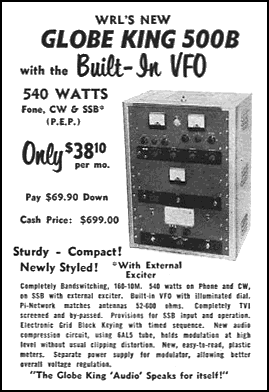![[Logo: Burstein-Applbee Electronics]](logos/ba_big.gif) The B-A logo was used by Burstein-Applebee Company, in Kansas City, MO. It is still the property of the Applebee family. More here! |
Boat
|
|
In reading the history of this industry, one thing strikes me. There just isn't a lot of future in making ham radios. The real money seems to be in military contracts, which are less speculative and more profitable, but even these didn't save a lot of companies. The Japanese may be an exception, as they don't do a lot of military work, but ham radio is pretty much a side line for them too. Their meat 'n' potatoes are marine and commercial radios, and then ham radio as the Japanese see it, which is often closer to (pardon the expression) a licensed version of our CB. Sure, there are a million hams in Japan, but most have a readily available, severely restricted license that allows only a couple of bands and modes. Even mighty RCA, which was way too big to ever have to depend on hams, and which for some years even owned the very concept of the superheterodyne itself, has pretty much vanished into the ether. Its historic building in New York, still the headquarters of NBC, now says "GE" on top. It's that kind of business. Most U.S. communication radios were originally made in three regions, possibly because the first companies clustered around the few plants that were licensed by RCA. There was one group in the Northeast, one in the Midwest, and one in California, generations before anyone had heard of Silicon Valley.
The California firms tended to concentrate in what is now a grungy part of L.A.'s Westlake district, near Alvarado and Venice Boulevard (where Gilfillan, now ITT's radar division, made radios on license from RCA). The Midwestern manufacturers were more spread out, like Collins in Iowa, Motorola in Illinois, and Drake in Ohio. Nearly all of these companies began in basements or garages, before or during World War II.
SSB required some circuit changes in receivers, but nothing fundamental. The BFO had to be refined, filter passbands had to be adjusted, AVC had to be tweaked, and ultimately product detectors replaced simple diodes. Stability, both mechanical and electrical, needed a magnitude of improvement. The common solution was a multiple conversion/ fixed HFO/ narrow-range PTO/ high first IF/ low last IF design, as pioneered by Collins. The signal flow of the receiver remained essentially unchanged from the 1930s, as it still does in today's superheterodynes. Transmitters, however, needed a complete rethinking. For most hams, transmitters had always been more fun than receivers They were simpler, and way easier to work on. Also, they tended to look like serious equipment, which they were. They could even kill you. Most transmitters were relatively simple oscillator/ multiplier/ driver/ PA chains, with class B modulators. However, SSB required considerably more complex designs, with filters or phase-shift networks to get rid of the carrier and unwanted sideband. Modulation took place at low level, early in the signal chain, and this modulated signal was heterodyned to the working frequency. PA's were set linear, instead of the more efficient class C. This design approach involved severe compromises to AM operation, and to a lesser extent CW, both of which are still way more fun on the 'boat anchors.' The ham radio became a complex mass of critically aligned circuits, best adjusted by trained techs with special test equipment. The average ham, even the technically aware one, couldn't just tweak a tx by ear anymore. Even so, the 60s began the gradual acceptance of small, self-contained transceivers, which could share a lot of the same mixer and filter circuits. Within a decade, these had replaced the roomfuls of equipment once associated with short wave radio. By the mid-70s, vacuum tubes remained a viable design approach only in the largest, external, linears, where they were a cheap, rugged alternative to high current, solid-state devices. Boat anchor linears, using heavy-duty components and commercial-grade output tubes, are very much with us today. The rest is history. Here are some manufacturers that boat anchor collectors should look out for:
B&W, a Pennsylvania company, started making transmitters for hams around 1939, and continued until the "battleship" style of gear declined in the late sixties.
Of course, when sideband came in, the 5100 had to be adapted, and it was, courtesy of the 51-SB, an equally neat-looking box that stood alongside the main transmitter. The combo did 180W PEP on sideband, using the phasing method. Later, there was a 5100-B, with its 51SB-B. Your roomful of equipment was rounded out by the LPA-1, a grounded grid linear, actually an ultra-linear, using two 813s in triode connection with inverse feedback. The LPA-1 sat on your desk. Its hulking HV supply, with its four 866s in a full-wave bridge, did not, unless you had a bigger desk than normal humans. The mercury in this thing is practically enough to make your home a haz-mat site in itself. Even so, this 2 kW PEP amp was made until the late sixties, sometimes in kit form. These are interesting circuit designs. This must have been a pretty nice sounding kW. In 1961, the 5100 was replaced by a big, rather strange box, the B&W 6100. Its case and panel matched the LPA-1 perfectly, as did its 100 watt output, CW or PEP. Internally, it looks like a pretty decent rig, with crystal sideband filters and 6146 finals. This radio is guaranteed a place in vacuum-tube lore, due to its use of a true, crystal controlled, frequency synthesizer. This had to be some kind of first for the ham market in general, not just for the tube era. One clunks the typically heroic bandswitch into position, then dials in the working frequency by turning three knobs on a black panel at the center of the otherwise grey box. These go to a couple of tube VXOs, a comparator, and an RF amp. Needless to say, the 6100 was an expensive rig, and ahead of its time. According to Raymond S. Moore, only 200 were made. A friend of mine has one. So there. B&W always had a whole line of amateur-grade accessories. Their TR switch, that allowed full break-in on CW, was popular. They still make antenna switches and such, plus a rather expensive, wide-coverage, dipole that sells well to the military. You can have one too, for only U.S. $100.
Central Electronics was started by Wes Schum, in the proverbial Chicago basement, in 1950. At the time, it was about the only company concentrating on advanced, phasing-type, SSB exciters for hams. The first one, the ten-watt (PEP) 10A, used a string of receiving tubes on all bands 160 to 10, derating power somewhat at the high end.
The 10A improved on an earlier product, from another company, that was called the SSB Junior. Your occasional 10A turns up at swap meets. It has no VFO, just crystals, and bandswitching is done by opening up a little door and changing coils. It's in a funky little grey box, with MULTIPHASE EXCITER in large letters across half the left side of the radio, flanking two sine waves that are most definitely 90 degrees out of phase. The 10A was followed in 1954 by an improved version, the 10B, in a slightly larger box, and the 20A, a higher-powered version with more features. It has a band switch, and at the top there is a magic-eye tube. There is an accessory VFO, the 458, though converted surplus VFOs were used as well.
The Central Electronics transmitters that everyone wants today are the later 100V and 200V. These are classics, perhaps as close to the state of the vacuum-tube art as anything made. For a start, the rig is completely broadbanded, like a no-tune ricebox of today. That's right. You don't have to tune your transmitter. Of course, this means that the load must be pretty close to 50-75 ohms, as with modern rigs. I suppose you could use an antenna tuner, and lose a bit on the convenience side. The PA, using the ultra-linear 6550 audio tubes in class AB1, is rated at 100W PEP on both radios. The CE200V is a somewhat later version of the 100V, with the same basic design but a lot of new tubes and features, giving it just about every bell and whistle anyone ever put into a tube transmitter. Both the 100V and 200V come in a heavy, impressive box, classic Collins grey, with a simplified control layout of two knobs, a turret dial, and two knobs. Other controls are behind two sturdy, spring-loaded doors. They're pretty much all set-and-forget. There's also an accessory signal analyzer scope in a matching box. The PTO has a very fine tuning step for a tube radio. To its left is a large meter, to its right a nifty modulation 'scope. This rig cost $800 in 1950s money, more than a lot of used cars, and you still needed a receiver. It was probably worth it, though. People will hock their children for these now. It's a great rig, if not one for the faint hearted. It's probably hell to work on, but it's a thing of beauty. At the time, the broadband coupler in the PA output circuit was regarded as black magic. Engineers for other companies would open up their 200Vs and try to see what made these couplers work. CE, however, had potted the whole thing in what looked a bit like dirty cement, requiring its total destruction to get to the guts. One was rewarded by a few bent, useless coils, which by then looked as if a car had run them over. There must have been a few 200Vs around with permanently tuned outputs, since CE would not replace these couplers without a darn good reason. Finally, there was a matching desktop linear, the 600L, with a single 813 in class AB2 running about 600W PEP. Yes, this was broadband too, in and out. You still didn't tune your radio. Think about these beautiful tube rigs, designed in the late 50s, the next time someone tells you what an advance the no-tune riceboxes were. In 1959, Central Electronics became wholly owned subsidiary of Zenith, with Schum staying on as a VP. Zenith management probably had trouble relating to such a high-end, low-volume product. These were definitely engineer's radios, and consequently they sold to a niche market. According to one of my sources, Zenith was really after Central's patents on phase-shift networks. These allowed a great simplification in the chroma demodulators of Zenith TV sets, eliminating four tube sections compared to RCA's design. In 1962, with patent rights firmly in hand, and only about 500 200Vs sold, Zenith abruptly discontinued the entire CE line, terminating it with extreme prejudice. There were wails of grief from hams, but that was that. In many ways, Collins was the prototype of the modern electronics company. While it started in Art Collins' basement in late summer of 1932, and could not afford to hire even one employee until a year later, Collins evolved into a big-time government and military contractor. It's hard to find a service or agency that doesn't have some Collins stuff around somewhere. Collins was eventually acquired by defense giant Rockwell, and Art Collins, W0CXX, retired a wealthy man. While Collins had started to sell gear to other hams, he also outfitted aircraft, expeditions, and the like. This history was exploited by the company's series of 'wing' logos, finally replaced by a dumb looking circle in the 1960s. When it came time to modernize Air Force communication by going to SSB, Collins was the logical choice. It didn't hurt that Curtis Le May and Art Collins were ham buddies.
Larger rigs, like the Collins broadcast and commercial transmitters, are perhaps the ultimate boat anchors. Like the ones made by RCA, Gates, Continental and the others, they are built to pump out photons on a 24/7 schedule, forever, with proper maintenance. They were, and are, incredibly expensive, often exceeding the cost of the buildings housing them, and they were, and are, ridiculously overdesigned for amateur use. They come in black, ominous racks, with meters all along the top, and windows where the operator can peer in and make sure the PA tubes are glowing the proper shade of red. An only slightly scaled down amateur example is the KW-1, perhaps the most formidable looking kilowatt ever made, which cost $5000 in the 1950s, when a veteran could buy a house for $15k. A 1950 Collins military design, the R-390/URR, pretty much started boat anchor collecting when it turned up in quantity on the surplus market. This 32-tube, 80-pound supermachine was probably the most complex vacuum-tube short wave receiver ever made. Even in the "$600-screwdriver" defense market, its price was an issue. In 1951, Collins designed a less expensive version, the R-390A, with "only" 26 tubes, but for the first time with mechanical filters in the IF. This one, as made by Collins and 15-25 other companies, sold 54,000+ units over a period of around 25 years. All went to government and military, except for one public 3rd-party sale in 1968. There is also a very rare R-391, with channel presets.
All 3 versions had two small meters, one for RF carrier level (an "S" meter) and one for audio line output. The numbers on these meters glowed in the dark. Therefore, they are now considered a radiation hazard (this IS the government we're dealing with here), and they are often missing, or bearing ominous yellow nuke stickers which you are supposed to leave on. Needless to say, there is something of a black market in R-390 meters. The first real boat anchor magazine, Electric Radio, originally started for the many people who'd become hooked on restoring and using these superboxes. When they first came on the market, they offered a level of performance on short wave broadcast reception that even the best new solid-state rigs could not exceed, and for usually only a couple hundred bucks. As word spread about what great radios these were, the price gradually took off. Just as the buzz was getting started, someone consigned a very nice Collins R-390A, in excellent condition and with meters, not to mention a little tool kit and extra tubes, for $200 cash-only no-return at Jun's Electronics in L.A.. After several months, I finally decided I had to have the thing. I cleared out a spot in my apartment, got the two hundred out of the bank, and arrived at the store to find the radio gone - sold that day. It's probably worth over $1000 now. You learn to move fast in the boat anchor business! Although it's an analog tube receiver, the R-390 has digital tuning, and it's completely mechanical! You don't service this subsystem with an alignment wand and a VTVM or scope. You service it with a wrench. It looks like the insides of a fine old grandfather clock. A bandswitching system of cams and lord-knows-what-else (the "Megacycle Change") turns a mechanical counter and selects the proper strip of huge cans behind all the gears and stuff. Then a "Kilocycle Change" knob dials a second mechanical counter while turning a huge canned PTO and simultaneously moving gangs of slugs in and out of the selected strip! Gee whiz, Mister Wizard!
Since it was intended for use with external audio amplifying equipment, the R-390 has two 600-ohm line driver outputs instead of an AF power amp. A rugged home stereo works fine for sound. You won't believe how good short wave broadcasting actually can sound on this level of equipment. You'll never listen to the BBC on your rice box again. Like most old boat anchors, the R-390 has a BFO, but it lacks a product detector for SSB. An expensive, outboard adaptor is available, also surplus. The R-390/390A is still a good first boat anchor. Keep in mind that if you really want an original Collins box you should be prepared to lay out some serious bucks. These are used radios, of course, so their relative level of quality is quite variable depending on the age, maintenance, mods by previous owners, and who made the particular unit in the first place. In the fifties, Collins got back into the civilian market with the 75A- series of receivers, and its matching 32V- amateur transmitters. Later, there was the 32W-1, a similar transmitter intended as an exciter. This one could be given a larger final and a power supply/ pedestal the size of a bar refrigerator, at which point it became a KWS-1, self-contained kilowatt on SSB and CW. The 75A-4/KWS-1 combo was a formidable looking station, at a formidable price, so hams started calling these "the gold dust twins." If you had to ask the price, you couldn't afford it.
Any of these old Collins are great boat anchors. They're big, and they have some advanced circuits for their time. The receivers were the first to use narrow segments with a precise PTO for tuning, changing bands by switching in 300 or 500 kHz ranges. Collins also made the industry standard mechanical filters that just about everyone used in their 455 kHz second IFs. Collins tube radios, with their large, black boxes, and covered with lights, dials and knobs, are among the most purposeful looking radios ever made. Most of the public still sees them on the sets of old movies and TV shows, along with the larger racks by Collins and Motorola. These have therefore pretty much formed the popular image of what really high-powered radios ought to look like, having won wars, gone to the moon, and maybe even shot down your occasional UFO.
The military wasn't ignored, with the high-priced 51J- and 51S- series of receivers, thousands of which were sold. The 51S- was transitional to Collins' later S-line, the sleek, miniaturized (by boat anchor standards) series of HF radios that redefined the medium in the 1960s. Another breakthrough product was the mid-50s KWM-1. This was a very forward-looking mobile/portable SSB transceiver covering 14-30 MHz. 20 years later, its general design approach with dual-use circuits and choice of power supply became standard in ham radios. For amateurs, the S-line meant the 75S- series of receivers and 32S- transmitters. The transmitter made good use of the compact 6146, a hot-rod beam pentode roughly derived from the 6L6, that became an industry standard. The receiver continued the "gold dust" design that remained the state of the amateur art.
There was also a heavy-duty linear, the 30S-1, which stood on the floor and looked like a sleeker KWS-1. Finally, there was the popular 30L-1 linear, which used 4 811As in a horizontal position, in a box the same size as the other S-line components. It was one of the first real, desktop KWs. This made it possible to put your whole S-line on a desk that looked like a desk, as opposed to a door and three sawhorses. Along with similar gear from R. L. Drake, these radios got away from the 'battleship' look of the 50s, while not compromising performance. Finally, Collins updated its KWM-1 transceiver into the KWM-2, with styling and general design approach much like the S-line. This radio became pretty much standard for certain military and MARS applications, and they ordered a lot of them. It had base-station performance in a truly portable (or mobile, with suitable power) package. You could even get a rather sturdy suitcase that would carry your KWM. Any old-time ham has very personal feelings about the Collins S-line. It came with a huge number of very useful accessories, third-party mods and goodies. This was awfully nice gear, and everybody wanted it, but, once again, the price was always just a little beyond the means of the average hobbyist with a mortgage and/or family. A lot of dreaming, and drooling, went on. It is no wonder that the mystique lasts to this day, giving the S-line an almost obscene resale value. It's worth it. It's still a great radio, maintainable forever, and a viable choice for the real radio freak who doesn't mind scrounging parts and opening a box now and again. Rockwell/Collins is still making very nice, usually cutting-edge, equipment, mostly for the military. A number of interesting communication services are still provided out of Cedar Rapids, with clients including Aeronautical Radio, Inc., the US Air Force, and the Drug Enforcement Agency. Art Collins died in 1987. His ham callsign is now being used by the Rockwell-Collins Employees Amateur Radio Club at the company's home in Cedar Rapids, Iowa.
 E.F. JohnsonEdgar F. Johnson started his mail-order parts business in 1923, in his Wisconsin bedroom. He moved into manufacturing parts, then into making whole radios. He gained a reputation for making sturdy, reliable gear which could take commercial 2-way use. After the war, Johnson came out with the classic boat anchor transmitter. To honor his Scandinavian heritage, he named it the Viking. It became the Viking II, and then led to the Viking Valiant/ Valiant II, with three 6146s instead of two, which was made until 1965. The Valiant is still popular with pirate radio stations. Its classic design considerably influenced the Heathkit DX-100, at one time the Model T of Heath's amateur line. The Valiant also had an SSB adaptor, giving an honest 275 watts PEP input. The Viking I and II were your typical enormous, rack-sized boxes, made like something you'd put on a bank vault, with a meter and an ominous little dial hole in the middle. They made an external VFO that was popular. Then you had two ominous little dial holes. The Valiant, and most later Johnson transmitters, went the other way, with the coolest VFO dials you'll ever see, and generally a very purposeful looking radio. The I series used dark browns and blacks, while the IIs went to a more contemporary (in 1960) grey and tan. These are beautiful radios. Everyone should have at least one.
One e-mailer wanted me to put in the Thunderbolt, a 2000W PEP linear made in the 60s. Sounds good to me. Actually, I can't believe I'd forget that one. It was a true desktop kW, if you had a very strong desk, with continuous coverage from 3.5 to 30 MHz. It switched to class C for CW, where 20W in got you the legal plate input, plus a wee bit more. In AM linear mode, it did an honest 800W input, pretty good for 33% efficiency. This thing cranked. Johnson also made a "6N2 Thunderbolt." 5 watts SSB/DSB in got you 1200W to the finals in class AB1, and six watts CW got you a happy kW of class C input on your favorite weak signal channel. Of course, you could not wear the 6N2 Thunderbolt on your belt at swap meets.
You've heard of The Smart Desk. Well, here was The 1000 Watt Desk. This was not a kW on a desk, it was a desk on a kW. Since there was also a class B modulator in there, your desk had a kW on AM too, if it had to, using 15 watts audio drive. Later came the Viking Invader, a modernized Valiant with internal SSB generation and 2 6146s. This was a pretty cool rig by itself, but it was also a bit like the old 32W-1, because you could put it on steroids. For about another $700, not chicken feed in those days, your Invader got new finals, an external box for the power supply, a new panel with some more dials, and another meter. Or, you could buy it this way in the first place. Either way, you had an Invader 2000, a self-contained rig that could make legal power, or a wee bit more, on SSB or CW. It's hard to go wrong with old Johnson transmitters. They're immortal, if you can come by tubes and parts. They work well, and they keep your room nice and warm. Johnson also made the Match Box, a very highly regarded antenna tuner of a sort they just don't make any more, but which everyone wishes they did. There's also a kW Match Box, same thing only bigger. Everybody wants one of these, very very badly. Riots break out at swap meets. Hams sell their wives. It's not pretty, folks. Ultimately the thriving land-mobile radio business replaced amateur as the company's core competency. Johnson became known for CBs and business radios. Today's EF Johnson is a leading maker of Project 25- compliant digital radios for public safety and military applications. It was purchased in 1997 by software manufacturer Transcrypt International. In 2005, its headquarters moved to Irving, Texas. In 2008, the company again changed its name, this time to EFJohnson Technologies. In 2010, EF Johnson Technologies was acquired by Francisco Partners, a private equity firm.
Gonset CompanyFaust Gonset, W6VR, was an old-time ham. In the 1930s, he contributed articles about transmitter modifications to RADIO magazine. In 1942, he co-edited the Radio Handbook, for years the major competition to the handbook put out by the ARRL. In fact, the West Coast-oriented RADIO gave QST a good run until just after WW II, when it tried to shift its focus to broadcast engineering, went bust, and was folded into CQ. In the forties, Gonset joined his father's company, bringing in some top ham radio engineering talent. The first noteworthy product was the legendary "Communicator" series of portable VHF transceivers. This was followed by a mobile converter, the "10/11," and the equally legendary "Commander," an HF mobile. When the FCC finally allowed mobile amateur operation in the 50s, Gonset was there, leading the pack with small, lightweight, mobile powered, and pretty much unbreakable, ham radios at affordable prices.
In the true boat anchors, Gonset made a series of rather odd looking HF receivers, vaguely reminiscent of the Motorola bases of the era, with funny bent panels, but about a zillionth of the workmanship of Motorola's commercial-grade gear. The full-size, Gonset transmitters were more conventional looking, in the standard battleship-style boxes. There was the GSB-100 exciter/transmitter, and the GSB-101 linear. Later on, a smaller desktop linear, the GSB-201 series, got the legal input from 4 811As. The Commander series was for portable HF use, with a rather purposeful looking 30-watt AM transmitter and matching receiver, both in absolutely tiny boxes, with little doors in front. The transmitter would do 30 watts AM, not bad for something that would fit a glove compartment. I have never seen one of these. The pictures make it look cool, like the airport radios of the era.
However, the most famous, and prevalent, Gonset radios were and are the Communicator series of AM transceivers for 6 and 2 meters. Gonset sold a bazillion of these. They were standard issue for Civil Defense/RACES and disaster communication. Both came in the same square, ungainly, metal box, looking a lot like something you'd keep bread in, but with SO-239 coax jacks on top. (This made a good place to screw on a whip antenna, when working outdoors in the field.) Early versions had "magic eye" tubes. Gonset also made an external amplifier, in a matching box, with the inevitable little window to look in and see how the finals (826s?) were doing. This little radio, known affectionately as the "Goony Box," was cheap to begin with, and even more so used. However, it could stand up to portable use, and it pretty much opened VHF to hams. It's hard to believe now, but most simplex and even duplex on VHF used to be AM. FM was later, when modified Motorola and GE land-mobile gear came into use.
Communicators went through several revisions, with Roman numerals, up to the IV, which had a more "modern" case. Later models had a sliderule dial instead of a rotary pointer. Their major competition was the Heathkit Sixer and Twoer, the classic "Benton Harbor Lunch Boxes." The Communicators are neat radios, popular with collectors and AMers. They're immortal. They still come up for sale at times, with or without the nuke-era yellow paint jobs, and/or the round CD logos. Gonset didn't survive the transition to solid state. Faust Gonset sold the company to one of his suppliers, then it was sold one more time in the 60s before vanishing without a trace. Faust Gonset stayed in the radio business, however. He started SBE, also in California. SBE, for Side Band Engineers, marketed the first truly miniature SSB transceiver in 1963. It wasn't quite all solid state, with tubes in the transmitter driver and PA, but it was still tiny, way smaller than most of today's HF gear, and with speaker and power supply built in. The SB-33 was up to Faust Gonset's usual engineering standards, with many dual-use "bilateral" circuits to cut complexity and create a true transceiver, in which major portions of the transmitter really were the receiver backwards. It was followed by the SB-34, more an update than a redesign. There were also a couple of matching linears. These weren't much bigger, so you had a base-station punch in a mobile-size footprint. All this means that the prototype 'ricebox' was not the FT-101. It was the SBE, made right here in these US of A. The radio was years ahead of its time. Gonset sold SBE, which passed through several owners, including Raytheon, whose later CBs had the SBE brand. Two very interesting transceivers, the SB-35 and 36, were assembled in Japan, but still never sold well. When Raytheon closed its San Francisco factory, it sold the brand name and line to David Thompson, who had been the marketing manager for land-mobile. SBE dropped amateur, but lasted several years longer making highly regarded CBs and scanners. One of these, the Opti-Scan, was among the first programmable scanners, which did not require that an expensive crystal be ground for each desired channel. Instead, the user would insert punch cards. Quite the advance, at the time. SBE also appears to be gone, or at least out of the radio business.
![[Circle h Logo]](logos/halliold.gif) Hallicrafters"The Radio Man's Radio," Hallicrafters was the personal creation of Bill Halligan in 1932. Halligan's early radios were hand crafted, and even signed by whichever employee built them. Hence the name, "Hallicrafters." Bill Halligan is yet another of the old-time radio people. He served as a wireless op in WW I, and built spark transmitters. In 1928, he started his first company, the precursor to Hallicrafters. It moved around, as RCA licenses became available, and ultimately located in Chicago. Its first communication receiver was the S-1 Sky Rider, a regen made in 1934. This bandswitching radio, still fairly innovative for the time, was the first in a line that lasted until the 1970s. Most of the comm radios had S- numbers, though for a long time the ones with crystal filters became SX-. Later still, when up-conversion came in and crystal filters went out, SX- seemed to label all of the top-line ham receivers, like the SX-101 and SX-115. The latter was not a state of the art design, and some consider it overrated, but it was a darn good radio for the ham bands. Not many were sold, as Collins and Drake had already put an end to the battleship era. Today the set has a certain mystique which is hard to explain, fetching absolutely ludicrous eBay prices.
Hallicrafters collecting is something of a hobby within a hobby, and it's easy to see why. The company always made a whole line of shortwave radios, clear from the bottom-end Sky Buddy, which kids could afford, to the inexpensive (OK, cheap) S-38/S-120, through mid-priced equipment, to gee-whiz high-tech gear which looked and sounded as formidable as anything ever made anywhere. The result is a dizzying array of Sky Buddies, Sky Riders, Sky Couriers, Sky Trainers and Sky just about everything else, all aimed at the consumer market, and in addition all the numbered models that could be used in the home or the shack. The company sold an awful lot of radios. They turn up in some very unlikely places. For example, the 'air band radio' seen in the office on the Wings TV series was an old Hallicrafters receiver, though they made a real aero radio that is something of a classic as well.
Anyone making this sheer volume of gear needs to make certain compromises, especially if they like staying in business. Hallicrafters tended to use generic, mass produced parts, which is good news and bad news today. The good news is that there are fewer custom parts for the restorer to locate. The bad news is that many a collector or user has opened up their Hallicrafters and recoiled. It looks like a cheap Silvertone in there! Even so, Hallicrafters made some incredible radios. One good example is the legendary DD-1, an absolutely visionary super-DX receiver that looks more like a 1930's movie space ship control panel. It's a double-diversity radio, covered with dials and meters. Basically, the intent was to incorporate into a production ham set the diversity concept being experimented with by amateurs looking for a solution to fading of AM phone DX. They never intended to sell a lot of them, as much as they intended to earn Hallicrafters the respect of the real hard core radio people. Therefore, only a couple hundred were made, and these cost as much as a new car. A good history of this high-end amateur set, along with photos that will make you drool, is right here. The DD-1 is definitely a major prize in any boat anchor collection. [The preceding paragraph was updated and corrected in June 2007. -Hugh]
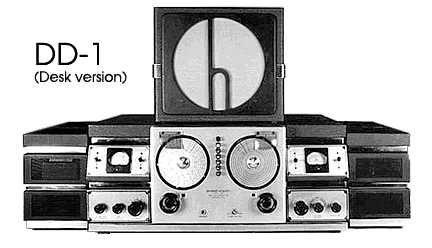 Hallicrafters also made some great transmitters, both for government/military and amateur. These tended to be true boat anchors, with some of the heaviest chassis in the industry, until they slimmed down considerably in the late 60s/early 70s. The ham line started with 1937's classic HT-1, in the same awesome case as the DD-1. This evolved into the legendary HT-4, an enormous, 350-watt, practically commercial-grade, transmitter weighing 400 pounds. When WWII came, Hallicrafters quickly adapted the HT-4B into a somewhat more rugged military version, the BC-610. A lot of these were incorporated into a self-contained HF comm station made for the Signal Corps. Despite its boat anchor gear and large antenna, the station was completely mobile in a truck, even towing its electric generator behind. Hallicrafters made a lot of these, and other military gear for all services. The company was justifiably proud of its Army/Navy "E" pennants for war production efficiency. After the war, Hallicrafters hit the ground running with a revived HT-4B, selling for $1500 in 1950. Back on earth, hams could buy the more modest HT-6, with an 807 final, and the midsize HT-9. These were followed by the modest little HT-17 and HT-18 beginner's rigs, a larger HT-19, and another 1950 heavyweight entry with the "TVI-proof" HT-20. (Hallicrafters, like Collins, addressed the new problem of television interference by increasing shielding and adding a built-in LP filter.) The HT-30 followed in the mid-50s, with somewhat more streamlined styling which carries over in the classic HT-32/32A-B of the 60s. The '32s are definitely in the best boat anchor tradition, weighing at least 85 pounds, and they are excellent radios. The HT-37 was quite a bit lighter (I could carry mine by myself, though just barely), mostly because Hallicrafters had skimped on the power supply and the materials used in the case. It fit into a mid-level ham line also including the SX-111 receiver and HT-41 linear. However, the HT-37 is highly prized today, because its balanced-modulator section, with phasing-mode sideband generation, is one of the nicest sounding rigs ever made. Use a suitable mike, like the high-Z D-104 without the preamp, keep the gain down, and you can be confident of having the best SSB audio on the band.
Amplifiers were the HT-31, in a heavy case resembling the HT-20, and the HT-33/33A-B series, companions to the HT-32 and using progressively more powerful tubes which easily made the "full gallon." In the 60s the beginner's rig was the HT-40/40A, then finally the trend away from the real boat anchors produces the interesting HT-44 and HT-46. There's also a lightweight, 3-400Z linear in this period, the HT-45 Loudenboomer, which came from an earlier product marketed by Radio Industries. A popular early electronic keyer was the Hallicrafters "T.O. Keyer," in a large case with built-in sidetone speaker. Unlike most such keyers in that era, it was a heavy-duty unit that could handle -65 volt grid circuits in big tube rigs. Many Hallicrafters general-coverage receivers, and even the ham-only SX-101/101A, had what became something of a trademark for this company, namely the giant, etched glass, slide-rule dial. Think Zenith Trans-Oceanic, then think way, way, WAY bigger. If you break one of these, you will need to cannibalize another radio for a replacement. They are practically church windows. The largest such dial was probably on the popular SX-62, an entertainment receiver which covered .540 to 108 MHz, continuously, switching to a separate IF strip with an FM discriminator on the higher bands. Yes, you could hear the cops on this one. It was a living room version of the turret dialed SX-42, which was itself derived from countermeasures receivers made in the war. The '62 has the classic, shortwave dial, covered with markers for Rome, Paris, Moscow, and other cities which may or may not have ever actually broadcast there. The SX-62 and 62A are extremely complicated sets, hard as hell to work on, though at least there's a Sams Photofact on it. It's prone to shaft stripping on the 12-section bandswitch, and Lord help you if the tuning drive cord needs restringing. However, I've actually used one for a ham radio, with an external relay to switch the antenna and speaker. The crystal filter does a nice job, though since the ENTIRE 40 and 20 meter bands are about half an inch wide, if anyone bumps the radio, your station is gone forever. It's a somewhat more practical set for MW AM DX, with the right antenna.
Hallicrafters also made a rather extensive line of consumer electronics. While some of this was pretty ordinary stuff, there were some classics. When TV came in, Hallicrafters made a desktop set with a small (12"?) screen and radio-style push buttons, in a case that looks a great deal like the one used for the SX-62. This TV, the T-54, is really hip right now, and you see it in a lot of design books. They study its looks in art schools. It's kind of halfway between 50s high-tech and 60s camp. Probably doesn't hurt that it had a channel 1, even after the FCC eliminated it in 1948. It was followed by the T-505, in a more living-room-friendly wooden box, then by a more standard line of larger screen TVs. WWII's spectacular production output left Hallicrafters a large company with 2500 employees at several big factories in the Chicago area. For most of the fifties, they kept up this output, selling most of the short wave receivers used by the public. Seems as if everyone had an old S-38 around somewhere. Ultimately, though, things seemed to decline. Northrop bought Hallicrafters in 1966, and tried to refocus it on military gear. The last amateur product was discontinued in 1972. Subsequently, Hallicrafters had a succession of new owners, and it now appears to have completely dissolved. Bill Halligan died in 1992, at age 93. The name has been re-registered and is now property of Professional Electronics Company, Inc.
![[Logo: Old Hammarlund]](logos/hmmrlun2.gif) HammarlundHammarlund was a very old company, and something of a pioneer. It was founded in the 1920s, by Oscar Hammarlund in Manhattan. Its initial Comet Super Pro line led to the legendary SP- series of comm receivers, that was made, by the thousands, until the 1970s. Later on, Hammarlund introduced the HQ- line of receivers at a more affordable price for hobbyists. These, too, were made by the thousands, until the early 70s. Oscar Hammarlund died in 1945, and was succeeded by his son, Lloyd. In the 50s, Hammarlund began a move to North Carolina, which became complete in 1965. The company was sold to Telechrome in the late 50s, then to Giannini Scientific. Hammarlund got into transmitters in the 50s and 60s, with its HX- series. The first ones were obviously intended as companions to the HQ- line of receivers, as the cases are quite similar. Just about all tube transmitters had turret dials for their VFOs, but Hammarlund's had a slide-rule dial more like what Hallicrafters put on its receivers. The later Hammarlund transmitters, plus the high-power, external linears, look quite a bit beefier, but they weren't big sellers and I don't know anything about them.
Hammarlund's top line, the Super Pro series, is the kind of thing that makes radio freaks drool. It never changed that much. It just got better. The best one is the last one, the redoubtable SP-600. Following the R-390, it's probably the receiver that defined the boat anchor scene.
SP-600s were built to a spec, not a price. A standard version ran $1000 in 50s money when $1500 bought a car, and the -VLF model ran $2000! Thousands of these were made, mostly for military and commercial use, sometimes with one of several different AN/FRR- or R- type designations. More than you ever wanted to know about the SP-600 Hammarlund continued selling the SP-600 until the very end. They did try to market solid state gear to hams, but it didn't sell. In the late 60s, Giannini sold the company to Electronic Assistance Corporation, which spun off assets, eventually selling all parts and stock (including the last few unsold SP-600-VLFs) to Cardwell Capacitor Corporation. The factory closed around 1972, and that was that.
![[Logo: Heath Company]](logos/heathkit.gif) Heath CompanyThis remarkable company began in Michigan around 1926, with fits and starts, by marketing an airplane in kit form. In fact, founder Edwin Heath died in a crash. After the war, Heath got into electronics with a low-cost oscilloscope kit using military surplus parts. Kit building became a popular pastime, not to mention a way to save some big bucks on equipment, and Heath's catalog came to include everything from electronic toys to TV sets, complete hi-fi systems, and eventually even computers. These invariably came from the hardscrabble industrial city of Benton Harbor, MI, better known as the home of the Whirlpool company. Heath always had two ham lines, one aimed at beginners, and one for the old-timer looking for a good rig at a good price. The beginner's gear was rudimentary, used few tubes, and typically cost next to nothing even in 50s and 60s money. Any kid could get on the air with this stuff, and a lot of them did. Just about everybody had a DX-40 around somewhere. The old timer gear was usually solid, using tried and true designs. Sometimes these were pretty close to other products that had proven successful in ham use. Open up a DX-100, and you'll find a pretty good imitation of the Johnson Viking. Both of these were workhorse transmitters on AM and CW, and the DX-100 had a later SSB adapter. In the 60s, Heath modernized its look, with a sleeker DX-60 transmitter, a matching receiver, and some big rigs named after Indian tribes. The Apache was kind of a hot-rod DX-100, and a popular boat anchor. It was followed by the more advanced (and harder to build) Marauder. There were linears, the Chippewa and Warrior, and the RX-1 Mohawk, a receiver. Unless a piece of gear was really complex, which it hardly ever was, the ham boxes came in kit form only. Thus every Heath boat anchor out there was built by some guy, in his garage or basement, with a soldering iron, a screwdriver, and a couple of little wrenches that Heath usually included. This dictated a certain approach to mechanical and electrical design. "We won't let you fail," was one of their slogans. The gear, especially the older transmitters, is usually pretty easy to work on, and there are a million mods out. Of course, it also means that some of these boat anchors will look like art works inside, while others will have solder splashed in funny places, or black tape around melted insulation from when smoke came out the first time. Caveat emptor! The later SB- series turns up at swap meets all the time. These look a lot like the Collins S-line, but with green panels and chrome knobs and about one-fifth the workmanship. A couple of linears, the SB-200 and SB-220, are still very popular. The 200 is about the size and power of the Collins 30L-1, but with much different controls and tubes. The 220 is a 200 on steroids, in a fatter box, and using 3-500Zs. There have been hundreds of articles with good 220 mods, mostly for stability and more RF choking at lower frequencies. The 220 remains a viable choice for the experienced BA type who understands the safety hazards of such high powered equipment, who won't blow himself/herself up, and who wants to make some serious RF, cheap.
Heath also made some interesting little transceivers, the Tener, Sixer and Twoer. These AM monobanders were also called the "Benton Harbor Lunch Boxes," which gives a pretty good idea of their size and shape. They even had little handles on top. Heath sold an awful lot of these, getting a lot of people onto the higher bands. Heath was bought by Daystrom in the 50s, followed in the 60s by a complex arrangement after Zenith bought the company. Gradually, as electronic gear became too complex to build from a pile of parts in a garage, the company shifted into computers, robotics and advanced home automation products. The rapidly-growing computer line gained a market share under the name Zenith Data Systems, while the robotics morphed into the popular line of Heath/Zenith home lighting and security products using infrared sensors. The educational division continued on as Heathkit Educational Systems. Finally, in 1991, the last kit was discontinued. After some further ownership changes, the lighting and security products division and the Heath Company brand name were sold to DESA International. These products remained on the market for quite some time, and may still be around, but the quality dropped off badly. The remnant company carried on in Michigan, still called Heathkit Educational Systems. In 2011, they started something called the Heathkit Company, Inc, and announced the intention of offering kits once again. Mention was made on the web site of a "Garage Parking Assistant" using ultrasound to to indicate the position of the car. This venture never had a chance. Parent HES succumbed to hard economic times in 2012, declaring bankruptcy and ceasing operation after defaulting on its lease.
 National Radio Company"Tuned to Tomorrow," National had a lot of yesterdays. It started in 1914, as a toy company, and moved gradually into the radio business in the twenties. National started out making premium parts for other companies, an approach that led to their traditional emphasis on quality. National radios never looked very fancy. They were just good.
After selling advanced HF/VHF radios to airlines and the government, National entered the ham market with a popularly priced line of regenerative receivers. Then, in 1935, they introduced our third classic boat anchor, the mighty, wide-coverage HRO. This series survived, with circuit refinements, until 1964, and it was popular and respected the whole time. That's a long run for a radio that never really stopped looking like an orange crate! The HRO had a number of special parts, as designed by none other than James Millen, most apparent being the huge, steel, tuning dial that came to symbolize National radios. This dial had little windows. When you turned it, the 100-kc (no Hertz yet!) would increment inside the windows, in the dial, while you read off the individual kc on the dial's outside. This awesome mass of chrome and steel looked like an ash tray, and it was made like the Great Pyramids. Even more remarkable was the band switch. Millen had a hand in here, as well. None of these crummy wafer switches, or coil banks, or turrets to oxidize and go out of alignment. To change bands on any HRO, the operator opens two spring-loaded clamps that could go on a bank vault, and pulls out a coil array something like 3 inches by 6 inches by 4 inches deep. Basically, you disembowel your radio. The huge coils are slid into the shelf box that lives next to every HRO, the proper new ones are slid out of the box, at which point you stick the new assembly back into the radio, where it seats with a satisfying ker-THOK. The spring clamps are snapped shut, and away you go. Now this is a radio! Millen, a mechanical engineer, moved on to his own parts company, which ran its whole catalog in the Radio Amateur's Handbook until the ARRL dropped all the ads. His stuff always looked pretty dramatic; the kind of technology that won World War II. Not flashy; just immortal. The newest and best of the tube HROs are the HRO-50 and HRO-60. Either one is made like a locomotive, and either will make yet another fine addition to the boat anchor collection, though it might also get you a divorce. They're rectangular boxes, heavy, heavy, heavy, with ominous slits along the top for the sliderule dial scale, and that redoubtable HRO tuner just below. There's an S-meter on the left, and the usual plethora of dials and knobs. Do get the matching speaker, if you can. The HRO made the solid state transition with the fully synthesized HRO-500. It still had the classic HRO dial, and very wide coverage from a dizzying 5 kHz to 30 MHz. It is reputed to be a very good radio, in fact a classic, but I've never seen one. It came along too late to save National's general-coverage line, and not that many were sold. Less well known is the last model with an HRO prefix, the rare HRO-600. This is a solid state, very high-end ($5500!) military-grade receiver aimed more at the surveillance and maritime markets. One of National's few transmitters was the NTX-30, made right before the war. It's supposed to be a nice rig, but I've never seen one. Power output was 30 watts plus, on four bands, from a single-ended pair of 6L6GCs in parallel. Doubler/driver stages are also 6L6s. CW only, but there was an input for a modulator. It's all rather beefy looking, in one of those black boxes that says "old transmitter" at a glance. In the 60s, National made a highly regarded NCX-5 transceiver with a mechanical digital dial, and its companion NCL-2000, a 2000W PEP desktop linear. Both units had a nice, purposeful look. The linear ran National's patented class AB2 circuit, and it quickly became known for a lot of punch given its compact size and relatively affordable price just under $600. PA tubes were ceramic 8122 tetrodes, costing only $31 each at the time. Here was an honest, full-power amp that you could re-tube without taking out a second mortgage. National sold something like 5000 of these linears, many of which are still in use today. It is said that component life is very good if the amp is run at "only" a kW out, maybe saving the full 1300 watts for pile ups.
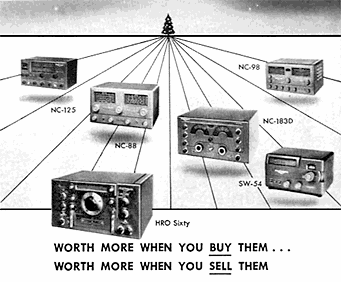
Like Hallicrafters, National hit the ground running after WWII with a whole line of short-wave receivers for the consumer market. Smallest and cheapest, at fifty bucks, was the "Mighty Midget" SW-54, an 11" by 7" by 7" general coverage box with built-in speaker and obviously aimed at the same low-end market as the Hallicrafters S-38 series. In the 60s, about when the S-38 was restyled into the sleeker S-120, National did similar with their $60 consumer-market NC-60.
The NC-300 was extremely sensitive, and generally a real good radio for its time. It had a matching speaker, the NC-300TS, with a very cool thunderbolt "N." There was also a similar-looking case that held up to three accessory VHF convertors, for 6, 2, and (believe it or not) 220 MHz. These were switched in from the receiver, and had their own scales on the big dial. Electrically, all three downconverted to a 30 MHz top band on the main set, which served as a tunable IF. The NC-300 was followed in 1958 by the NC-303 ($450), an improved version of the 300 which still shows up on a lot of all-time favorite lists right next to such legendary iron as the R-390, 75A-4, and SP-600! It had more filters, two different noise limiters, and a built-in Q-multiplier/ notch filter. The NC-303 lasted until the end of the boat anchor era in 1962. The last National tube box that I know much about is the later NC-270. Advertised in the mid-60s as "the red-hot set with the cool blue look," it was decidedly slimmed-down and "modernized." It had a multi-band sliderule dial a la Hallicrafters and a "cosmic blue" case that tilted up on a "flip foot" for ergonomics. I got to use one of these. It's a good enough set, once again with nice big controls that click satisfyingly into place, but otherwise as a mid-price box it can't compete with the 300 series. National left the ham business soon after, surviving on government contracts until going chapter 11 in the 80s. It hung on, barely, until 1991, when the last vestiges were sold off in an IRS foreclosure.
![[Logo: R.L. Drake]](logos/drake.gif) R.L. DrakeDrake is the exception, a privately held, American, family business that has managed to stay afloat selling gear to civilians, though they have had your occasional military contract. Robert Drake started the company in 1943, eventually moving to larger quarters in Miamisburg, Ohio, and then to an even nicer plant in Franklin. It's hard for me to be objective about Drake, because I think it's a great company. Drake started by selling filters to the military in World War II. These were good filters, and when interference from ham radios to TV sets became a problem after the war, they were easily adapted. I wish that I had kept my old TV-1000LP and its high-pass companion, that an Elmer had given me when I was learning ham radio. They beat anything made now. While Collins got all the credit for revolutionizing ham radio, Drake was actually there first, with its line of compact base station SSB receivers, the 1A, 2, 2A and 2B. These looked kind of dinky, especially when put alongside the heavy metal of the era, but they used advanced circuitry with a design philosophy similar to the Collins, and they tuned SSB like real champs. They became instant classics, as witness the obscene prices fetched by the 1A on eBay. Drake's numbering convention continues to this day. The first model in a new line gets a new sequential number, like an airplane, and then the refinements get letters. It is always chronological. The 2B was especially well received. It was simply a great receiver, sensitive and stable. It put one more nail in the rapidly expanding coffin of "battleship" gear which needed a dedicated room for its use. Next, Drake got into transceivers, the TR-3 and 4. I sound like a broken record, but the TR-4/ 4A is a neat radio, with its little square box, and its external speaker/power supply. There was also an accessory RV-4, which added another VFO. Right now, there are plenty of these transceivers at swap meets, and they can easily be restored and put right back onto the air. It's a simple, little radio that does simple, little things, but you can't beat it for the price. Next, Drake issued its famous 4-line of separates. They really hit their stride here. First came the R-4, and the T-4, a companion 'reciter' without a VFO, for slaving to the receiver. With the R-4A came the T-4X, a transmitter in its own right, with its own VFO/PTO plus transceive capability, like the Collins. Further improvements were made in the R-4B/T-4XB, and R-4C/T-4XC. There was also a linear, the L-4B, with full legal output, and a couple of shortwave receivers, the prized SPR-4 and the broadcast-oriented SW-4. The 4-line had a mindboggling array of accessories, from filters (of course!) to external frequency synthesizers (the FS-4), antenna tuners (the well regarded MN-200 and MN-2000), RTTY terminals, control consoles and generally just about any commercially viable idea that the engineers could think up. There's been some debate over whether the 4-line should really count as a boat anchor. It was transitional; a hybrid design. Each revision had fewer tubes and more solid state devices. In size and weight, these were more like dinghy anchors, though the PS-1 power supply could at least keep a car from rolling. Amazingly, the 4-line is still a viable choice today. It's about the best value on the used market. It lacks the Collins mystique, but also the Collins prices. I'm using one as my primary station right now, and I'd stack it up against any ricebox made. My experience comes close to what I feel when using the better Kenwood radios, like the TS-940 and 950, and the Drake is even about the same size! Operating the 4-line feels a lot like using the Collins S-line, minus the reasurring sturdiness of the Collins. About the only time this becomes a technical drawback is with the finicky "sweep tube" final of the T4X series, as compared to the rock-solid 6146s in the Collins. Furthermore, the R-4 may be the most listenable ham receiver ever made. It's like getting a better antenna, or moving to a desert island. The filters in the R-4B and C differ, and both have their adherents, but to my ears the R-4B is the winner. You simply don't get tired from using this radio, even in all-night contest QRM. In fact, many hard-core contesters and DXers hung onto their 4-lines until only a couple of years ago, when computer automation of logging, duping, band changing, etc. required more sophisticated transceivers. After this came the 7-line, all solid state, and in a redesigned, spacey, blue motif. The TR-7 was a ham transceiver, with a power supply in a matching case, and the R-7 was a very good, general coverage, fully synthesized receiver with a similar look. Like the R-4, the R-7 has its fanatics, who won't listen to anything else. It's a winner, even though it is rather hard to tune. Once again, Drake just kept getting out every kind of high-tech, or even just plain gee-whiz, accessory anyone could ever imagine.
This period also had some rare, amazing radios, such as the UV-3. This extremely advanced transceiver had modules that put it on as many as 3 VHF/UHF bands at once, run from an advanced control head that has been hacked, interfaced, and adapted for more remote bases than seems possible. The UV-3 was at least 10 years ahead of its time, and more if you include the excellent 220 MHz band, which for a long time was left off Japanese radios. (There's no 220 in Japan.) In the 80s, Peter Drake, who had replaced his late father, got the company into satellite TV receivers. These were made with typical Drake quality. The demand was huge, and Drake dropped all of its other products to concentrate on them. This led to an epic closeout sale at ham stores. In the 1990s, Drake broadened its line with a number of video, CATV, and assisted listening products. Happily, it also got back into radio with it's very successful R-8 series. There were also brief advertisements of an amateur transceiver. Unfortunately, it didn't last. In 2005, Drake once again withdrew from HF radio products. While the excellent R-8B was still a steady seller, it could no longer recoup the cost of parts without a major price hike, and management chose to discontinue it. Too bad. The company, however, remains a going concern. Its current core products are cable and digital TV systems. In 2012, Drake was acquired by Blonder Tongue Laboratories, Inc., though it remains a separate entity in Franklin, OH.
![[World Radio Ad]](images/wrl_logo.gif) World Radio LaboratoriesWRL started as Wholesale Radio Laboratories in Council Bluffs, Iowa in 1935. Its owner, Leo Meyerson, W0GFQ, already had quite a bit of radio experience by then, being something of a pioneer broadcaster and ham in the Midwest since age 10. After Pearl Harbor, Meyerson went in with a friend to start a company making military radio crystals for the duration of the war. After the war, he returned to WRL, changing its name to World Radio Laboratories. Thus arose a number of Midwestern businesses involved in retail and manufacture of kit and wired transmitters for hams.
WRL Manufacturing, a subsidiary, began offering the Globe line of sturdy, reliable AM/CW transmitters, using proven circuit designs with comfortable operating margins. This is great equipment. All but the smallest beginner's rigs had full high-level AM modulation, and all but the massive Globe King 500 were available kit or wired. These transmitters included:
The Globe King 500 was a true boat anchor, with modular chassis in racks several feet high and weighing hundreds of pounds. Borrow a pickup truck to get this thing home. It has separate decks for power/VFO, modulator (811As), and RF (single 4-400A, driven by a 6146). The modulator has its own power supply, for better regulation when cranking audio through the 6AL5 limiter. This is very heavy duty stuff, reliable and serviceable, like commercial gear. The transformers alone in this awesome rig probably weigh more than some other people's radios. WRL made quite a few other accessories and kits. In 1953, the company name was changed to WRL Electronics, and then to Globe Electronics in 1956. In 1959, the company was sold to Textron. Meyerson continued in the retail radio business with World Radio, and then got back into manufacturing with Galaxy Electronics in 1962. The Galaxy line of innovative SSB transceivers was highly regarded. They also made linears, and a CB. This company was sold to Hy-Gain in 1970. Meyerson retired in 1977, dividing his time between Omaha and the California desert, and continuing as an active amateur well into his 90s. He was Ham of the Year at Dayton in 1997. His collection of over 200 ham radios went to a museum in Omaha, where its current status is not known. The parent company, World Radio, continued in the retail business, making a transition to consumer electronics with a large chain of Midwestern stores run by Leo's son Larry. This business was sold in 1988, and declared Chapter 11 a year later, closing most of its stores. It is not known if the company still exists. |
More to come!!!!
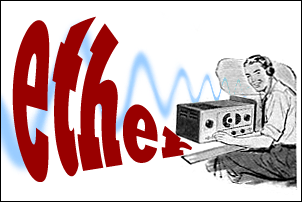
Back to RF Section
Back to tubepage
Last revised 5/12
-- .- -.-- -... .
-.-- --- ..- .-.
..-. .. -. .- .-..
-.-. --- ... - ...
.---- .-.-.- ..--- ----.
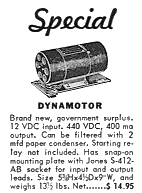 Many of the Northeastern companies began in small factories on Manhattan's Radio Row, which later became the country's primary retail source for WW II surplus gear and esoteric electronics in general. In 1966, Radio Row's few blocks along Cortlandt and Greenwich were utterly obliterated for construction of, ironically enough, the World Trade Center.
Many of the Northeastern companies began in small factories on Manhattan's Radio Row, which later became the country's primary retail source for WW II surplus gear and esoteric electronics in general. In 1966, Radio Row's few blocks along Cortlandt and Greenwich were utterly obliterated for construction of, ironically enough, the World Trade Center. 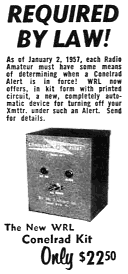 After World War II, HF voice radio started out pretty much with prewar AM technology, but soon began the slow conversion to the far more efficient SSB. It's true that hams invented sideband, but not that they perfected it. The phone company was using it in the 1930s. The ARRL pushed hard for its adoption after the war, but the real impetus for conversion came when General Curtis "Iron Ass" LeMay got the U.S. Air Force to adopt sideband for all of its HF comm. After this, it was only a matter of time for hams, and just about everyone else on HF. AM didn't die out completely, and it remains a fine ragchewing mode and a viable hobby within a hobby, but for 99.99% of hams the quack-quack sound became standard.
After World War II, HF voice radio started out pretty much with prewar AM technology, but soon began the slow conversion to the far more efficient SSB. It's true that hams invented sideband, but not that they perfected it. The phone company was using it in the 1930s. The ARRL pushed hard for its adoption after the war, but the real impetus for conversion came when General Curtis "Iron Ass" LeMay got the U.S. Air Force to adopt sideband for all of its HF comm. After this, it was only a matter of time for hams, and just about everyone else on HF. AM didn't die out completely, and it remains a fine ragchewing mode and a viable hobby within a hobby, but for 99.99% of hams the quack-quack sound became standard.
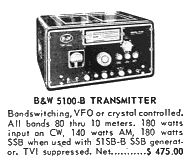 B&W picked up after the war with its small VFO/exciter, which led quickly to the mighty 5100 series of AM/CW boxes in the fifties. These very formidable, grey, rack-size transmitters used the then-new 6146. There were two in the final, and two more in the class B, high-level modulator. Here was an AM box with some balls!
B&W picked up after the war with its small VFO/exciter, which led quickly to the mighty 5100 series of AM/CW boxes in the fifties. These very formidable, grey, rack-size transmitters used the then-new 6146. There were two in the final, and two more in the class B, high-level modulator. Here was an AM box with some balls!
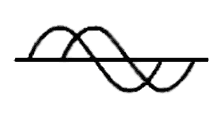
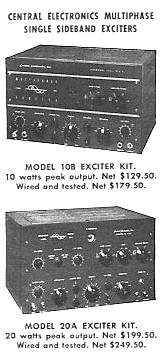
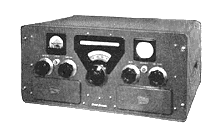
![[WING LOGO]](logos/collinsw.gif)
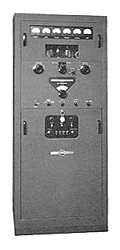
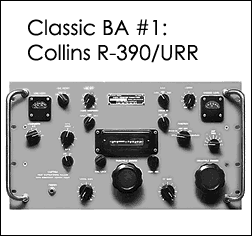
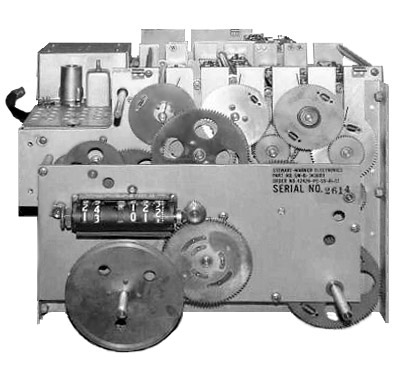
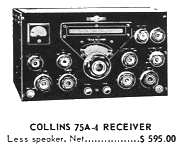 The 75A-4 is a great radio. It was the new state of the art at the time, and some companies spent the rest of the vacuum tube era catching up. You could get an enormous speaker, the 312A-1, that wasn't that much smaller than the receiver. The whole thing made one of the most listenable radios ever made, way better than 99% of ultra-speced solid state boxes with their zillion dB dynamic ranges.
The 75A-4 is a great radio. It was the new state of the art at the time, and some companies spent the rest of the vacuum tube era catching up. You could get an enormous speaker, the 312A-1, that wasn't that much smaller than the receiver. The whole thing made one of the most listenable radios ever made, way better than 99% of ultra-speced solid state boxes with their zillion dB dynamic ranges.
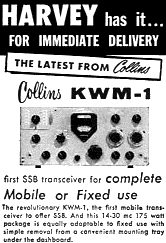

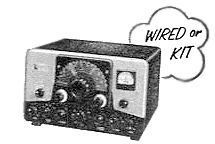 The Viking line was well received, and no wonder, because it was an awfully good transmitter. A smaller version of the Valiant, called the Ranger/ Ranger II, was made at the same time, having a single 6146 and no SSB adaptor. It was just about the best little rig available to novices (I liked mine, and the VFO gave me incentive to upgrade). A larger rig, the 500, had an external power supply, bigger finals, and an 811A modulator, for 500 honest AM/CW watts. I believe the sideband adaptor worked with this rig too. The "6N2," a transverter, got you up on, uh, six and two.
The Viking line was well received, and no wonder, because it was an awfully good transmitter. A smaller version of the Valiant, called the Ranger/ Ranger II, was made at the same time, having a single 6146 and no SSB adaptor. It was just about the best little rig available to novices (I liked mine, and the VFO gave me incentive to upgrade). A larger rig, the 500, had an external power supply, bigger finals, and an 811A modulator, for 500 honest AM/CW watts. I believe the sideband adaptor worked with this rig too. The "6N2," a transverter, got you up on, uh, six and two.
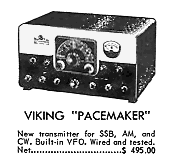 Finally, Johnson made a couple of small transmitters aimed at novices, a couple of middle-sized transmitters like the Pacemaker, a 500W desktop linear called the Courier, and a couple of huge transmitters aimed at people who, uh, wanted huge transmitters. The earliest of these was the Viking Kilowatt, an ominous, square, grey box standing some 4 feet high, 3 feet wide and 5 feet deep, with controls on top, and generally looking more like a VAX than a radio. Since it was 'only' an amplifier, Johnson made a matching, metal desk which attached to the side, and gave a place to put your exciter, receiver, and yourself.
Finally, Johnson made a couple of small transmitters aimed at novices, a couple of middle-sized transmitters like the Pacemaker, a 500W desktop linear called the Courier, and a couple of huge transmitters aimed at people who, uh, wanted huge transmitters. The earliest of these was the Viking Kilowatt, an ominous, square, grey box standing some 4 feet high, 3 feet wide and 5 feet deep, with controls on top, and generally looking more like a VAX than a radio. Since it was 'only' an amplifier, Johnson made a matching, metal desk which attached to the side, and gave a place to put your exciter, receiver, and yourself.
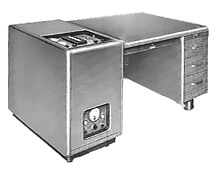
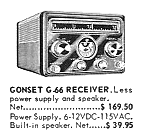 For example, Gonset made an early, HF mobile receiver, the G-66, and a matching transmitter, the G-77, both of which would fit easily under a dashboard. They were cool looking little boxes, kind of like shinier spy radios, with external power supplies and modulators that went somewhere else (the trunk?). They only used AM, but they covered all the HF bands.
For example, Gonset made an early, HF mobile receiver, the G-66, and a matching transmitter, the G-77, both of which would fit easily under a dashboard. They were cool looking little boxes, kind of like shinier spy radios, with external power supplies and modulators that went somewhere else (the trunk?). They only used AM, but they covered all the HF bands.
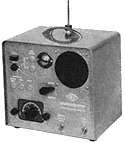
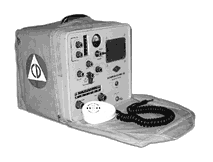
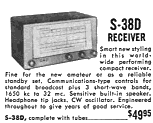
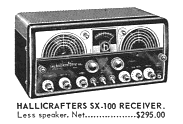
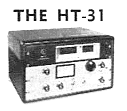
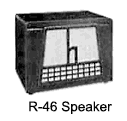 Also look out for Hallicrafters speakers, the R- series. They match the output impedances of the receivers, and just generally look cool. The enormous R-42, designed to work with the SX-42's 8-watt 6V6 audio section, has a hi-fi/ communication response switch and a real sci-fi bass port. The SX-62, with a similar audio output, can use it too, though by then there was a slightly more domesticated R-46, the one with that famous Hallicrafters "h" all the way up the grille. Of course, there was a small communication-audio speaker too, the little R-47, which looks suspiciously like the ones Motorola sold with its VHF cop radios.
Also look out for Hallicrafters speakers, the R- series. They match the output impedances of the receivers, and just generally look cool. The enormous R-42, designed to work with the SX-42's 8-watt 6V6 audio section, has a hi-fi/ communication response switch and a real sci-fi bass port. The SX-62, with a similar audio output, can use it too, though by then there was a slightly more domesticated R-46, the one with that famous Hallicrafters "h" all the way up the grille. Of course, there was a small communication-audio speaker too, the little R-47, which looks suspiciously like the ones Motorola sold with its VHF cop radios.

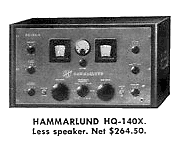 The HQ- receivers were large, in the real boat anchor style. The HQ-140 had those ominous, gun-port-like, little holes through which you read the dials (the Super-Pro commercial/military series had these too). Later HQ- models were more generally streamlined, still large boxes, but hardly heavyweight ones, with bigger openings. The HQ-170 was ham bands only, the -180 was general coverage. These radios also had a large, strange, Telechron clock in one corner, matching the large S-meter in the center. The clock, which could turn on the radio, was optional at a cost so low that there was no excuse NOT to get it. However, you still see a lot of radios with just a dumb, empty hole plugged up with a cheesy logo. Yuk. Hams are such cheapies.
The HQ- receivers were large, in the real boat anchor style. The HQ-140 had those ominous, gun-port-like, little holes through which you read the dials (the Super-Pro commercial/military series had these too). Later HQ- models were more generally streamlined, still large boxes, but hardly heavyweight ones, with bigger openings. The HQ-170 was ham bands only, the -180 was general coverage. These radios also had a large, strange, Telechron clock in one corner, matching the large S-meter in the center. The clock, which could turn on the radio, was optional at a cost so low that there was no excuse NOT to get it. However, you still see a lot of radios with just a dumb, empty hole plugged up with a cheesy logo. Yuk. Hams are such cheapies.
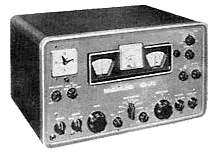

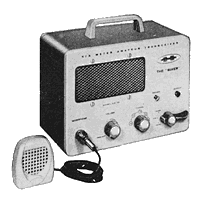
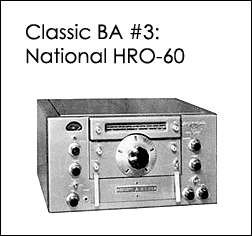
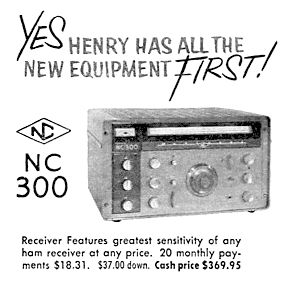 Over on the amateur side, National came out in the mid 50s with the NC-300, another whopping BIG radio (64 pounds), with good mechanics, and a band switch that went CLUNK into place. Its design followed a well-publicized "dream receiver" promotion, and it was definitely a high-end ($400) unit that the operator wouldn't get tired of. While sliderule dials were sometimes woefully inadequate on ham band radios, this one was huge, and extremely usable.
Over on the amateur side, National came out in the mid 50s with the NC-300, another whopping BIG radio (64 pounds), with good mechanics, and a band switch that went CLUNK into place. Its design followed a well-publicized "dream receiver" promotion, and it was definitely a high-end ($400) unit that the operator wouldn't get tired of. While sliderule dials were sometimes woefully inadequate on ham band radios, this one was huge, and extremely usable.

